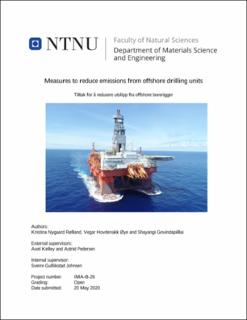| dc.contributor.advisor | Johnsen, Sverre Gullikstad | |
| dc.contributor.advisor | Kelley, Axel Edward | |
| dc.contributor.advisor | Pedersen, Astrid | |
| dc.contributor.author | Rølland, Kristina Nygaard | |
| dc.contributor.author | Øye, Vegar Hovdenakk | |
| dc.contributor.author | Godvindapillai, Shayangi | |
| dc.date.accessioned | 2020-07-22T16:01:29Z | |
| dc.date.available | 2020-07-22T16:01:29Z | |
| dc.date.issued | 2020 | |
| dc.identifier.uri | https://hdl.handle.net/11250/2669923 | |
| dc.description.abstract | Hensikten med denne bacheloroppgaven har vært å studere hvordan Lundin Energy Norge AS sin lete- og produksjons aktivitet bidrar selskapets totale utslipp av CO2 og NOx, både i et historisk og fremtidig perspektiv, og for å vurdere effekten av iverksatte tiltak. Prosjektgruppen har videre identifisert ytterlige tiltak som redusere utslipp av CO2 og NOx fra offshore boreraktivitet på norsk kontinentalsokkel og vurdert hvordan Lundin Energy Norge AS sine virksomhetsmål støtter de nasjonale utslippsreduksjonsmålene for 2030 og 2050.
Gjennom litteraturstudie ble informasjon om selskapet og fremtiden til olje-industrien fra lundin-energy.com og Norsk olje og gass (NOROG) sine årlige rapporter brukt som hovedkilder, der miljostatus.miljodirektoratet.no ble brukt som hovedkilde for mer generell informasjon. Dataene som er brukt som grunnlag for resultatene er hentet fra intervjuer med personell hos Lundin Energy Norway AS´, Lysaker kontor, telefonmøte med NOROG og et besøk på boreriggen som er brukt som eksempel i oppgaven (West Bollsta) på Hanøytangen utenfor Bergen. Estimater og sitarer fra selskapets eksperter er blitt notert fortløpende i møtereferater, og forretningssensitiv informasjon som er blitt behandlet og brukt er referert, men ikke lagt inn som kilder. Grafene som er presentert i resultater er tilpasninger fra dataene som er innsamlet og består av flere antagelser og estimater, og derfor er utregningene avrundet grunnet usikkerheten.
Om bord på West Bollsta er Selektiv Katalytisk Reduksjons-teknologi blitt installert, og har vist utslippsreduserende effekt på opptil 70% for NOx-gasser. «Closed Bus-Tie»-teknologien som er installert reduserer oppe-tiden til dieselmotorer, som igjen reduserer diesel-forbruket til West Bollsta, mens den samtidig opprettholder sikkerhetsreguleringene til DNV-GL. Denne teknologien må derimot optimaliseres bedre for å bli essensiell for overgangen mot et lav-karbons samfunn.
Konklusjonen fra oppgaven er at elektrifisering av plattformer vil være veien videre for norsk petroleum industri på norsk kontinental sokkel i fremtidige år, da det gir store utslippsreduksjoner. Når det gjelder fremtiden for bore-rigger er det en større usikkerhet. Prosjektgruppen har kommet frem til at energistyringssystemer på borerigger vil være avgjørende for å redusere utslipp i kommende år. For at både Lundin Energy Norway AS og Norge skal nå klimamålene og reguleringene, må borerigger effektiviseres ytterliggere. Energistyringssystem vil hjelpe stort, men er ikke nok til å fjerne alle utslipp. I fremtiden kan lav-utslipps drivstoff og brenselceller være noen av teknologiene som vil bli brukt i motorer på borerigger på norsk kontinental sokkel. | |
| dc.description.abstract | The purpose of this bachelor thesis has been to study how Lundin Energy Norway AS´s offshore drilling and petroleum production activity contributes to the company´s total emission of CO2 and NOx, both in a historic and future perspective, and to assess the effect of implemented measures. The project group have also identified additional measures that reduces these emissions of CO2 and NOx from offshore drilling rig activity on the Norwegian Continental Shelf and assessed how Lundin Energy Norway AS´s corporate targets support the national emission reduction targets for 2030 and 2050.
Through the literature study the main sources, lundin-energy.com as well as Norwegian Oil and Gas Association´s annual reports have been frequently used to gather information regarding the company and the future of the petroleum industry. Websites like miljostatus.miljodirektoratet.no has been basis for the more general information. The data collected in this thesis has been gathered through interviews at Lundin Energy Norway AS’, Lysaker office, cell phone meeting with Norwegian Oil and Gas Association (NOROG) and a rig visit to the West Bollsta rig at Hanøytangen outside Bergen. Quotations and explanations from company experts has been written down on a continuous basis during the meetings, and business sensitive information is referenced to but not added to citations. The graphs represented are adaptations of the data collected and consist of several assumptions and estimations and therefore the uncertainty cannot be fully determined.
On the West Bollsta rig, the implemented Selective Catalytic Reduction shows a NOx-reduction of up to 70%, which complies with any regulation. The Closed Bus-Tie technology optimizes the utilization of the diesel engines and cuts the total running hours. This reduces the diesel consumption on West Bollsta and thereby the CO2 emission with 9%, while still maintaining safety regulations from DNV-GL. However, the technology must be further optimized to become essential for achieving the low-carbon society goal.
This thesis has concluded that electrification on platforms on the Norwegian Continental Shelf obtain substantial cuts in emission and will be an important initiative for the Norwegian petroleum industry in the coming years. Regarding drilling rigs, the future is more uncertain. The project group has concluded that energy management systems on drilling rigs will be crucial in reducing emissions over the next few years. For Lundin Energy Norway AS and the Norwegian petroleum industry to meet the defined environmental targets and requirements, drilling rigs must implement more efficient ways of reducing CO2 and NOx emissions. Energy management will greatly help but will not be enough to eliminate all emissions. Implementation of low-emission fuel as well as using fuel cells as a supplementary power supply may be the future for drilling rigs on the Norwegian Continental Shelf. | |
| dc.publisher | NTNU | |
| dc.title | Measures to reduce emissions from offshore drilling units | |
| dc.type | Bachelor thesis | |
